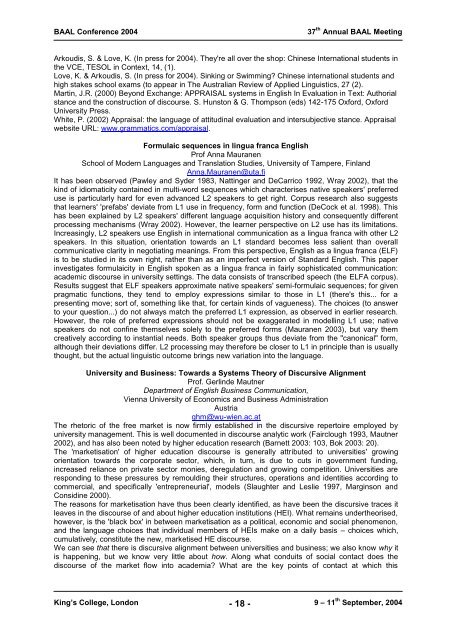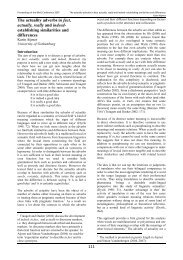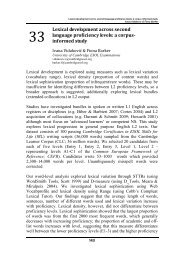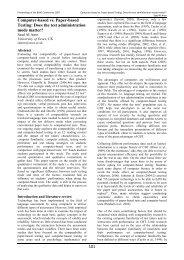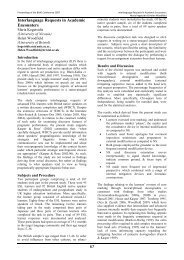Colloquia - British Association for Applied Linguistics
Colloquia - British Association for Applied Linguistics
Colloquia - British Association for Applied Linguistics
Create successful ePaper yourself
Turn your PDF publications into a flip-book with our unique Google optimized e-Paper software.
BAAL Conference 2004 37 th Annual BAAL Meeting<br />
Arkoudis, S. & Love, K. (In press <strong>for</strong> 2004). They're all over the shop: Chinese International students in<br />
the VCE, TESOL in Context, 14, (1).<br />
Love, K. & Arkoudis, S. (In press <strong>for</strong> 2004). Sinking or Swimming? Chinese international students and<br />
high stakes school exams (to appear in The Australian Review of <strong>Applied</strong> <strong>Linguistics</strong>, 27 (2).<br />
Martin, J.R. (2000) Beyond Exchange: APPRAISAL systems in English In Evaluation in Text: Authorial<br />
stance and the construction of discourse. S. Hunston & G. Thompson (eds) 142-175 Ox<strong>for</strong>d, Ox<strong>for</strong>d<br />
University Press.<br />
White, P. (2002) Appraisal: the language of attitudinal evaluation and intersubjective stance. Appraisal<br />
website URL: www.grammatics.com/appraisal.<br />
Formulaic sequences in lingua franca English<br />
Prof Anna Mauranen<br />
School of Modern Languages and Translation Studies, University of Tampere, Finland<br />
Anna.Mauranen@uta.fi<br />
It has been observed (Pawley and Syder 1983, Nattinger and DeCarrico 1992, Wray 2002), that the<br />
kind of idiomaticity contained in multi-word sequences which characterises native speakers' preferred<br />
use is particularly hard <strong>for</strong> even advanced L2 speakers to get right. Corpus research also suggests<br />
that learners' 'prefabs' deviate from L1 use in frequency, <strong>for</strong>m and function (DeCock et al. 1998). This<br />
has been explained by L2 speakers' different language acquisition history and consequently different<br />
processing mechanisms (Wray 2002). However, the learner perspective on L2 use has its limitations.<br />
Increasingly, L2 speakers use English in international communication as a lingua franca with other L2<br />
speakers. In this situation, orientation towards an L1 standard becomes less salient than overall<br />
communicative clarity in negotiating meanings. From this perspective, English as a lingua franca (ELF)<br />
is to be studied in its own right, rather than as an imperfect version of Standard English. This paper<br />
investigates <strong>for</strong>mulaicity in English spoken as a lingua franca in fairly sophisticated communication:<br />
academic discourse in university settings. The data consists of transcribed speech (the ELFA corpus).<br />
Results suggest that ELF speakers approximate native speakers' semi-<strong>for</strong>mulaic sequences; <strong>for</strong> given<br />
pragmatic functions, they tend to employ expressions similar to those in L1 (there's this... <strong>for</strong> a<br />
presenting move; sort of, something like that, <strong>for</strong> certain kinds of vagueness). The choices (to answer<br />
to your question...) do not always match the preferred L1 expression, as observed in earlier research.<br />
However, the role of preferred expressions should not be exaggerated in modelling L1 use; native<br />
speakers do not confine themselves solely to the preferred <strong>for</strong>ms (Mauranen 2003), but vary them<br />
creatively according to instantial needs. Both speaker groups thus deviate from the "canonical" <strong>for</strong>m,<br />
although their deviations differ. L2 processing may there<strong>for</strong>e be closer to L1 in principle than is usually<br />
thought, but the actual linguistic outcome brings new variation into the language.<br />
University and Business: Towards a Systems Theory of Discursive Alignment<br />
Prof. Gerlinde Mautner<br />
Department of English Business Communication,<br />
Vienna University of Economics and Business Administration<br />
Austria<br />
ghm@wu-wien.ac.at<br />
The rhetoric of the free market is now firmly established in the discursive repertoire employed by<br />
university management. This is well documented in discourse analytic work (Fairclough 1993, Mautner<br />
2002), and has also been noted by higher education research (Barnett 2003: 103, Bok 2003: 20).<br />
The 'marketisation' of higher education discourse is generally attributed to universities' growing<br />
orientation towards the corporate sector, which, in turn, is due to cuts in government funding,<br />
increased reliance on private sector monies, deregulation and growing competition. Universities are<br />
responding to these pressures by remoulding their structures, operations and identities according to<br />
commercial, and specifically 'entrepreneurial', models (Slaughter and Leslie 1997, Marginson and<br />
Considine 2000).<br />
The reasons <strong>for</strong> marketisation have thus been clearly identified, as have been the discursive traces it<br />
leaves in the discourse of and about higher education institutions (HEI). What remains undertheorised,<br />
however, is the 'black box' in between marketisation as a political, economic and social phenomenon,<br />
and the language choices that individual members of HEIs make on a daily basis – choices which,<br />
cumulatively, constitute the new, marketised HE discourse.<br />
We can see that there is discursive alignment between universities and business; we also know why it<br />
is happening, but we know very little about how. Along what conduits of social contact does the<br />
discourse of the market flow into academia? What are the key points of contact at which this<br />
King‟s College, London 9 – 11 th - 18 -<br />
September, 2004


